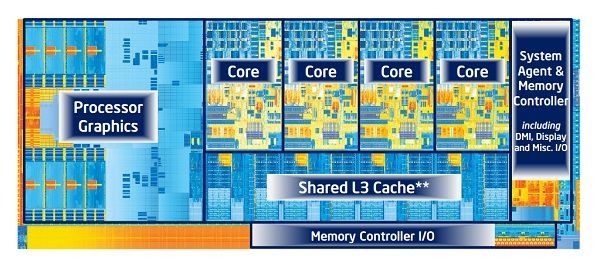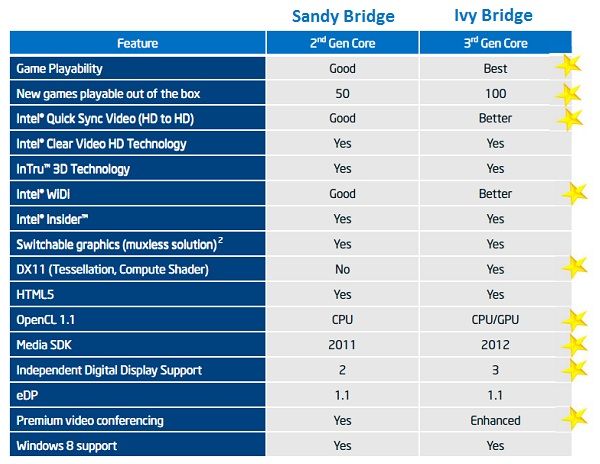If you’ve been following along the last few days, you saw us highlight plenty of Ultrabook deals for those looking to snag a machine on the cheap for Black Friday or Cyber Monday. The deals came in many shapes and sizes and often spanned the gap between first generation (Sandy Bride) and second generation (Ivy Bridge) Ultrabooks. If you haven’t been following the Ultrabook space closely, as we have, you might be confused about the difference. This article aims to clear that up and tell you how to identify one from the other.
First and Second Generation Ultrabooks, Second and Third Generation Processors
All the ‘generation’ talk can be a bit confusing because there are two separate parts to consider.
First there is the Ultrabook itself. This is a term trademarked by Intel. Then there are the processors: the first generation of Ultrabooks launched in 2011 and were based on Intel’s ‘Sandy Bridge’ processors. The second generation of Ultrabooks launched in 2012 and are based on Intel’s ‘Ivy Bridge’ processors.
Now here’s where the confusion happens — Sandy Bridge is the second generation of Intel’s ‘Core’ series of processors. There was no Ultrabook based on the first generation of these processors. Thus, the first generation of Ultrabooks are based on the second generation of Core processors (Sandy Bridge). The second generation of Ultrabooks are based on the third generation of Core processors.
What’s the Difference Between Sandy Bridge and Ivy Bridge?
Like other CPU manufacturers, Intel is constantly redesigning their processors to be faster, more secure, and more power efficient. In broad terms, the difference between Sandy Bridge and Ivy Bridge is one year of development that Intel has done to improve the processor.
On a technical level, there are many differences between Sandy Bridge and Ivy Bridge. The most identifiable is an upgraded graphics component. Sandy Bridge uses Intel’s integrated HD 3000 graphics processor. Ivy Bridge uses and updated version, aptly named HD 4000.
HD 4000 is up to twice as fast as HD 3000 and this will make a big impact on games and other GPU-intensive applications. Here’s a detailed overview of the features of HD 4000.
Another important difference is that Ivy Bridge supports faster RAM (up to 1600MHz) and more total system RAM (up to 32GB). Sandy Bridge only supports RAM up to 1333MHz and 8GB of total memory.
Furthermore, Sandy Bridge supports up to two displays. This could be your Ultrabook’s display and an external monitor, or two external monitors. Ivy Bridge supports up to three displays, meaning you could use your Ultrabook’s display and two external monitors, or three external monitors (provided you’ve got the proper outputs!).
This chart from Intel shows a few more differences between Sandy Bridge and Ivy Bridge:
There’s more if you dig into the bits and bytes as well. Here’s a technical comparison between the ultra-low-voltage Sandy Bridge Core i7 processor that is used in first-generation Ultrabooks and the Ivy Bridge Core i7 processor found in second-generation Ultrabooks.
How to Tell the Difference Between Sandy Bridge and Ivy Bridge
Because differences in performance between Ivy Bridge and Sandy bridge can be quite significant it’s best to make sure you know which one you are buying. It is common, as we saw while sifting through Black Friday and Cyber Monday Ultrabook deals, to find both Sandy Bridge and Ivy Bridge versions of the same Ultrabook available. Some companies continue to offer Sandy Bridge Ultrabooks at a reduced price over the same Ultrabook with Ivy Bridge. We’ve seen Dell try to get away with selling a Sandy Bridge Ultrabook as a “new” product even while simultaneously selling other Ivy Bridge devices; we don’t want anyone to get ripped off, so here’s a few rules of thumb for telling the difference:
- The full processor name will always be a giveaway. Sandy Bridge (second generation) processors are marked with a 2xxx identifier while Ivy Bridge (third generation) processors are marked with 3xxx. This is always a dead giveaway the best way to be sure which is which. The other numbers following the first digit identify the specific processor; you can ignore them if you just want to know the difference between Sandy Bridge and Ivy Bridge. For example:
- Intel Core i7-2677M = Sandy Bridge (second generation)
- Intel Core i7-3517U = Ivy Bridge (third generation)
- Sometimes the full processor name either isn’t available or is buried deep in other info. Another easy way to tell the difference between Sandy Bridge and Ivy Bridge is to see if the Ultrabook is using HD 3000 or HD 4000. As mentioned above, Sandy Bridge (second generation) uses integrated HD 3000 graphics. Ivy Bridge (third generation) uses HD 4000. If you find this on a spec sheet you can tell with a high degree of confidence whether you are looking at Sandy Bridge or Ivy Bridge.
- Note: Sometimes companies mix up HD 3000 and HD 4000 when listing products. You might occasionally see a unit listed as having a Core i7-3xxx processor and HD 3000 though in reality you’ll never find an Ivy Bridge processor with HD 3000 graphics. It is almost always best to trust the processor identifier (3xxx) if you find these two pieces of info in conflict.
Still Not Sure?
If you’re still confused about whether you’re looking at a Sandy Bridge or Ivy Bridge Ultrabook you can always consult Intel’s excellent Ark processor archive. Just type the CPU identifier (the 2xxx or 3xxx part of the name) into the search box at the top right and you can pull up a detailed list of processor info, including whether it is Sandy Bridge or Ivy Bridge (this is noted right toward the top of the info table). You can also compare processors (as linked above) which can be quite useful.













Great job Ben. I’m sure this article will be useful to a lot of people over the next 6-12 months.